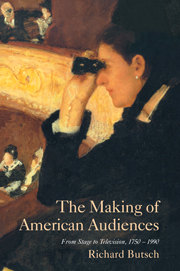Book contents
- Frontmatter
- Contents
- Acknowledgments
- Introduction: Participative Public, Passive Private?
- 1 Colonial Theater, Privileged Audiences
- 2 Drama in Early Republic Audiences
- 3 The B'Hoys in Jacksonian Theaters
- 4 Knowledge and the Decline of Audience Sovereignty
- 5 Matinee Ladies: Re-gendering Theater Audiences
- 6 Blackface, Whiteface
- 7 Variety, Liquor, and Lust
- 8 Vaudeville, Incorporated
- 9 “Legitimate” and “Illegitimate” Theater around the Turn of the Century
- 10 The Celluloid Stage: Nickelodeon Audiences
- 11 Storefronts to Theaters: Seeking the Middle Class
- 12 Voices from the Ether: Early Radio Listening
- 13 Radio Cabinets and Network Chains
- 14 Rural Radio: “We Are Seldom Lonely Anymore”
- 15 Fears and Dreams: Public Discourses about Radio
- 16 The Electronic Cyclops: Fifties Television
- 17 A TV in Every Home: Television “Effects”
- 18 Home Video: Viewer Autonomy?
- 19 Conclusion: From Effects to Resistance and Beyond
- Appendix: Availability, Affordability, Admission Price
- Notes
- Selected Bibliography
- Index
- Plate section
15 - Fears and Dreams: Public Discourses about Radio
Published online by Cambridge University Press: 05 June 2012
- Frontmatter
- Contents
- Acknowledgments
- Introduction: Participative Public, Passive Private?
- 1 Colonial Theater, Privileged Audiences
- 2 Drama in Early Republic Audiences
- 3 The B'Hoys in Jacksonian Theaters
- 4 Knowledge and the Decline of Audience Sovereignty
- 5 Matinee Ladies: Re-gendering Theater Audiences
- 6 Blackface, Whiteface
- 7 Variety, Liquor, and Lust
- 8 Vaudeville, Incorporated
- 9 “Legitimate” and “Illegitimate” Theater around the Turn of the Century
- 10 The Celluloid Stage: Nickelodeon Audiences
- 11 Storefronts to Theaters: Seeking the Middle Class
- 12 Voices from the Ether: Early Radio Listening
- 13 Radio Cabinets and Network Chains
- 14 Rural Radio: “We Are Seldom Lonely Anymore”
- 15 Fears and Dreams: Public Discourses about Radio
- 16 The Electronic Cyclops: Fifties Television
- 17 A TV in Every Home: Television “Effects”
- 18 Home Video: Viewer Autonomy?
- 19 Conclusion: From Effects to Resistance and Beyond
- Appendix: Availability, Affordability, Admission Price
- Notes
- Selected Bibliography
- Index
- Plate section
Summary
In the early years of broadcasting almost everyone had some opinion about the future of radio, its promise and dangers. Theater managers, newspaper and music publishers, even preachers debated its effect on attendance. Some early commentators expressed great hopes for radio as a source of cultural uplift for the masses. Others feared the degenerative social, psychological, and aesthetic effects of commercial radio. How would it affect other cultural institutions, the family and children, education, political campaigns?
Commerce clashed with aesthetic interests in these discourses. In the 1920s owners and managers of other entertainments worried whether radio might woo away their audiences. When these fears proved unfounded, they accommodated themselves to the new medium and it to their own needs. Cultural elites, on the other hand, soon realized that commercial radio would not fulfill their dreams for educating the masses. Rather than become accommodated to this unfortunate conclusion, they assailed radio's content and motives, and mounted campaigns to restrict or reform it.
The conflict between commercial and cultural interests recapitulated earlier struggles over leisure between commerce and social reformers. Through the nineteenth century, elite reformers worried about working-class pleasures and attempted to shape them through public regulation and facilities. They met with little success in either forcing or persuading working-class adults and children to follow their instructions.
- Type
- Chapter
- Information
- The Making of American AudiencesFrom Stage to Television, 1750–1990, pp. 219 - 234Publisher: Cambridge University PressPrint publication year: 2000

